A Novel Optimization for GPU Mining Using Overclocking and Undervolting
Abstract
:1. Introduction
1.1. Our Contributions
1.2. Organization of Paper
2. Background
2.1. Cryptocurrency Mining
2.2. Different Methods of Mining Cryptocurrencies
2.3. Mining Pools
2.4. Hardware Required for Mining
3. Proposed Methodology
- Overclocking is a technique of enhancing the GPU’s omission retention-and center timer rates to speeds higher than those specified by the manufacturer. You can increase the power limit when overclocking, but bear in mind that this will increase power utilization. The overclocking technique is best for lower-end GPUs, such as the Nvidia GTX series of GPUs, as they have less memory and lower clock speeds compared to the newer generation of cards, such as the RTX series cards. Effectiveness is crucial in mining because it affects global profitability.
- Undervolting the GPU is another important technique which helps the GPU to consume less power than the default power consumption of the GPU. When a GPU is undervolted, its energy consumption falls by around 30%, and its blower rate will be reduced by 33%. As a result, the GPU may run at a lower temperature and consume less power.
- In regard to mining optimization, Monero will use a new algorithm known as RandomX. We will go through how to overclock your GPU, which will help you optimize your earnings when mining with the RandomX algorithm. By performing a GPU overclocking, you could damage the GPU, so to overcome this issue we have also implemented undervolting techniques, which help the GPU to run with less power. RandomX mining is dependent on GPU clock speeds and VRAM. Our tests with different GPU clock speeds on RTX 3060 Non-LHR GPU yielded different results. Tests were performed on a system with 8 RTX 3060 GPUs. The results might change depending on which GPUs use clock speeds and VRAM better in their mining rig.
- Hardware Optimization is the core part our paper. When it comes to undervolting the GPUs, we have utilized the MSI AFTERBURNER software to undervolt and overclock the GPUs. When it comes to undervolting we have reduced the power consumption by 20% from its default power consumption, which is 225 watts. We have managed to reduce it to 180 watts for each GPU and we have used 8 RTX 3060 GPUs which are Nvidia’s custom-made GPU design called “Founders Edition”. With overclocking, we have increased the clock speeds of the GPUs with the afterburner itself. Its base clock speed was 1320 MHz and we have boosted the clock speeds to 1777 MHz, which uses the GPU to its maximum. Even though overclocking will increase the temperatures significantly, the undervolting technique will ensure the temperatures will not increase, as the power consumption will be reduced. With the help of these GPU Mining techniques, we have managed to increase the mining efficiency from 100% to 147%, which really adds to to the overall mining. All the experimental results are listed down below in Section 4 Experimentation Results.
- XRP Stak
- Miner Gate
- Monero Spelunker
- CC Miner
4. Experimentation Results
5. Discussion
6. Conclusions and Future Works
Author Contributions
Funding
Institutional Review Board Statement
Informed Consent Statement
Data Availability Statement
Acknowledgments
Conflicts of Interest
References
- Iyer, S.G.; Pawar, A.D. GPU and CPU accelerated mining of cryptocurrencies and their financial analysis. In Proceedings of the 2018 2nd International Conference on I-SMAC (IoT in Social, Mobile, Analytics and Cloud), Palladam, India, 30–31 August 2018; pp. 599–604. [Google Scholar]
- Gundaboina, L.; Badotra, S.; Tanwar, S. Energy and Resource Consumption in Cryptocurrency Mining: A Detailed Comparison. In Proceedings of the 2021 9th International Conference on Reliability, Infocom Technologies and Optimization (Trends and Future Directions) (ICRITO), Noida, India, 3–4 September 2021; pp. 1–5. [Google Scholar]
- Dev, J.A. Bitcoin mining acceleration and performance quantification. In Proceedings of the 2014 IEEE 27th Canadian Conference on Electrical and Computer Engineering (CCECE), Toronto, ON, Canada, 4–7 May 2014; pp. 1–6. [Google Scholar]
- Han, R.; Foutris, N.; Kotselidis, C. Demystifying crypto-mining: Analysis and optimizations of memory-hard pow algorithms. In Proceedings of the 2019 IEEE International Symposium on Performance Analysis of Systems and Software (ISPASS), Madison, WI, USA, 24–26 March 2019; pp. 22–33. [Google Scholar]
- Sukharev, P.V.; Silnov, D.S. Asynchronous mining of ethereum cryptocurrency. In Proceedings of the 2018 IEEE International Conference Quality Management, Transport and Information Security, Information Technologies (IT&QM&IS), St. Petersburg, Russia, 24–28 September 2018; pp. 731–735. [Google Scholar]
- Rauchberger, J.; Schrittwieser, S.; Dam, T.; Luh, R.; Buhov, D.; Pötzelsberger, G.; Kim, H. The other side of the coin: A framework for detecting and analyzing web-based cryptocurrency mining campaigns. In Proceedings of the 13th International Conference on Availability, Reliability and Security, Hamburg, Germany, 27–30 August 2018; pp. 1–10. [Google Scholar]
- Alkaeed, M.K.; Alamro, Z.; Al-Ali, M.S.; Al-Mohammed, H.A.; Khan, K.M. Highlight on Cryptocurrencies Mining with CPUs and GPUs and their Benefits Based on their Characteristics. In Proceedings of the 2020 IEEE 10th International Conference on System Engineering and Technology (ICSET), Shah Alam, Malaysia, 9 November 2020; pp. 67–72. [Google Scholar]
- Shao, J.; Ma, J.; Li, Y.; An, B.; Cao, D. GPU Scheduling for Short Tasks in Private Cloud. In Proceedings of the 2019 IEEE International Conference on Service-Oriented System Engineering (SOSE), San Francisco, CA, USA, 4–9 April 2019; pp. 215–2155. [Google Scholar] [CrossRef]
- Mukhopadhyay, U.; Skjellum, A.; Hambolu, O.; Oakley, J.; Yu, L.; Brooks, R. A brief survey of cryptocurrency systems. In Proceedings of the 2016 14th Annual Conference on Privacy, Security and Trust (PST), Auckland, New Zealand, 12–14 December 2016; pp. 745–752. [Google Scholar]
- Ghimire, S.; Selvaraj, H. A survey on bitcoin cryptocurrency and its mining. In Proceedings of the 2018 26th International Conference on Systems Engineering (ICSEng), Sydney, NSW, Australia, 18–20 December 2018; pp. 1–6. [Google Scholar]
- Talwar, B.; Arora, A.; Bharany, S. An Energy Efficient Agent Aware Proactive Fault Tolerance for Preventing Deterioration of Virtual Machines Within Cloud Environment. In Proceedings of the 2021 9th International Conference on Reliability, Infocom Technologies and Optimization (Trends and Future Directions) (ICRITO), Noida, India, 3–4 September 2021. [Google Scholar]
- Badotra, S.; Panda, S.N. Evaluation and comparison of OpenDayLight and open networking operating system in software-defined networking. Clust. Comput. 2020, 23, 1281–1291. [Google Scholar] [CrossRef]
- Sukharev, P.V. Hardware overclocking to improve the efficiency of ethereum cryptocurrency mining. In Proceedings of the 2020 IEEE Conference of Russian Young Researchers in Electrical and Electronic Engineering (EIConRus), St. Petersburg, Russia, 27–30 January 2020; pp. 1873–1877. [Google Scholar]
- Bharany, S.; Sharma, S.; Khalaf, O.I.; Abdulsahib, G.M.; Al Humaimeedy, A.S.; Aldhyani, T.H.H.; Maashi, M.; Alkahtani, H. A Systematic Survey on Energy-Efficient Techniques in Sustainable Cloud Computing. Sustainability 2022, 14, 6256. [Google Scholar] [CrossRef]
- Badotra, S.; Panda, S.N. SNORT based early DDoS detection system using Opendaylight and open networking operating system in software defined networking. Clust. Comput. 2021, 24, 501–513. [Google Scholar] [CrossRef]
- Li, J.; Li, N.; Peng, J.; Cui, H.; Wu, Z. Energy consumption of cryptocurrency mining: A study of electricity consumption in mining cryptocurrencies. Energy 2019, 168, 160–168. [Google Scholar] [CrossRef]
- Bhatia, S.; Alam, S.; Shuaib, M.; Alhameed, M.H.; Jeribi, F.; Alsuwailem, R.I. Retinal Vessel Extraction via Assisted Multi-Channel Feature Map and U-Net. Front. Public Health 2022, 10, 858327. [Google Scholar] [CrossRef]
- Govender, L. Cryptocurrency Mining Using Renewable Energy. An Eco-Innovative Business Model; Thesus: Helsinki, Finland, 2019. [Google Scholar]
- Badotra, S.; Panda, S.N. A review on software-defined networking enabled iot cloud computing. IIUM Eng. J. 2019, 20, 105–126. [Google Scholar] [CrossRef] [Green Version]
- Kiranbir, K.; Bharany, S.; Badotra, S.; Aggarwal, K.; Nayyar, A.; Sharma, S. Energy-efficient polyglot persistence database live migration among heterogeneous clouds. J. Supercomput. 2022, 1–30. [Google Scholar]
- Egiyi, M.A.; Ofoegbu, G.N. Cryptocurrency and climate change: An overview. Int. J. Mech. Eng. Technol. 2020, 11, 15–22. [Google Scholar]
- Mohsin, K. Cryptocurrency & Its Impact on Environment; Elsevier: Amsterdam, The Netherlands, 2021; Available at SSRN 3846774. [Google Scholar]
- Kumar, S. Review of geothermal energy as an alternate energy source for Bitcoin mining. J. Econ. Econ. Educ. Res. 2021, 23, 1–12. [Google Scholar]
- Bharany, S.; Sharma, S.; Bhatia, S.; Rahmani, M.K.I.; Shuaib, M.; Lashari, S.A. Energy Efficient Clustering Protocol for FANETS Using Moth Flame Optimization. Sustainability 2022, 14, 6159. [Google Scholar] [CrossRef]
- Fadeyi, O.; Krejcar, O.; Maresova, P.; Kuca, K.; Brida, P.; Selamat, A. Opinions on sustainability of smart cities in the context of energy challenges posed by cryptocurrency mining. Sustainability 2019, 12, 169. [Google Scholar] [CrossRef] [Green Version]
- Rusovs, D.; Jaundālders, S.; Stanka, P. Blockchain mining of cryptocurrencies as challenge and opportunity for renewable energy. In Proceedings of the 2018 IEEE 59th International Scientific Conference on Power and Electrical Engineering of Riga Technical University (RTUCON), Riga, Latvia, 12–14 November 2018; pp. 1–5. [Google Scholar]
- Zhang, T.; Pota, H.; Chu, C.C.; Gadh, R. Real-time renewable energy incentive system for electric vehicles using prioritization and cryptocurrency. Appl. Energy 2018, 226, 582–594. [Google Scholar] [CrossRef]
- Corbet, S.; Lucey, B.M.; Yarovaya, L. The Financial Market Effects of Cryptocurrency Energy Usage; Elsevier: Amsterdam, The Netherlands, 2019; Available at SSRN 3412194. [Google Scholar]
- Sumit, B.; Sundas, A. A systematic review on security of E-commerce systems. Int. J. Appl. Sci. Eng. 2021, 18, 1–19. [Google Scholar]
- Kang, E.S.; Pee, S.J.; Song, J.G.; Jang, J.W. A blockchain-based energy trading platform for smart homes in a microgrid. In Proceedings of the 2018 3rd International Conference on Computer and Communication Systems (ICCCS), Nagoya, Japan, 27–30 April 2018; pp. 472–476. [Google Scholar]
- Han, D.; Zhang, C.; Ping, J.; Yan, Z. Smart contract architecture for decentralized energy trading and management based on blockchains. Energy 2020, 199, 117417. [Google Scholar] [CrossRef]
- Amit, S.; Badotra, S.; Alotaibi, Y.; Alghamdi, S.; Khalaf, O.I. Modified Bat Algorithm for Op’imal VM’s in Cloud Computing. CMC-Comput. Mater. Contin. 2022, 72, 2877–2894. [Google Scholar]
- Zohuri, B.; Nguyen, H.T.; Moghaddam, M. What is the Cryptocurrency. Is It a Threat to Our National Security, Domestically and Globally? Int. J. Comput. Phys. 2022, 3, 1–14. [Google Scholar]
- Gallersdörfer, U.; Klaaßen, L.; Stoll, C. Energy consumption of cryptocurrencies beyond bitcoin. Joule 2020, 4, 1843–1846. [Google Scholar] [CrossRef]
- Lokesh, G.; Badotra, S.; Bhatia, T.K.; Sharma, K.; Mehmood, G.; Fayaz, M.; Khan, I.U. Mining Cryptocurrency-Based Security Using Renewable Energy as Source. Secur. Commun. Netw. 2022, 2022, 4808703. [Google Scholar]
- Bharany, S.; Sharma, S.; Badotra, S.; Khalaf, O.I.; Alotaibi, Y.; Alghamdi, S.; Alassery, F. Energy Efficient Clustering Scheme for Flying Ad-Hoc Networks Using an Optimized LEACH Protocol. Energies 2021, 14, 6016. [Google Scholar] [CrossRef]
- Chen, L. Research on Programming Model and Compilation Optimization Technology of Multi-Core GPU. J. Phys. Conf. Ser. 2022, 2173, 012080. [Google Scholar] [CrossRef]
- Rahmani, M.K.I.; Shuaib, M.; Alam, S.; Siddiqui, S.T.; Ahmad, S.; Bhatia, S.; Mashat, A. Blockchain-Based Trust Management Framework for Cloud Computing-Based Internet of Medical Things (IoMT): A Systematic Review. Comput. Intell. Neurosci. 2022, 2022, 1–14. [Google Scholar] [CrossRef] [PubMed]
- Shuaib, M.; Hassan, N.H.; Usman, S.; Alam, S.; Bhatia, S.; Agarwal, P.; Idrees, S.M. Land Registry Framework Based on Self-Sovereign Identity (SSI) for Environmental Sustainability. Sustainability 2022, 14, 5400. [Google Scholar] [CrossRef]
- Bharany, S.; Kaur, K.; Badotra, S.; Rani, S.; Kavita Wozniak, M.; Shafi, J.; Ijaz, M.F. Efficient Middleware for the Portability of PaaS Services Consuming Applications among Heterogeneous Clouds. Sensors 2022, 22, 5013. [Google Scholar] [CrossRef]
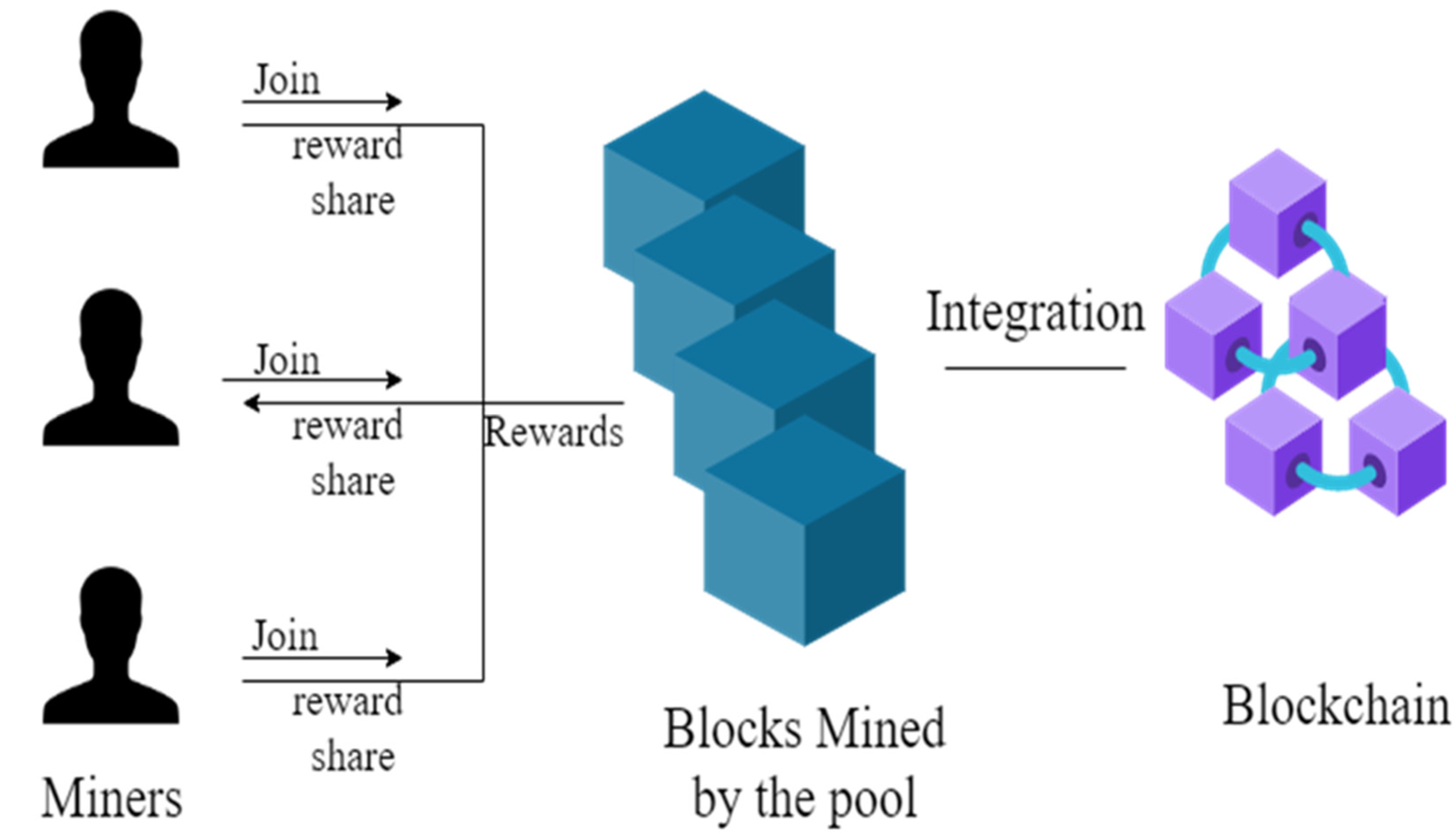

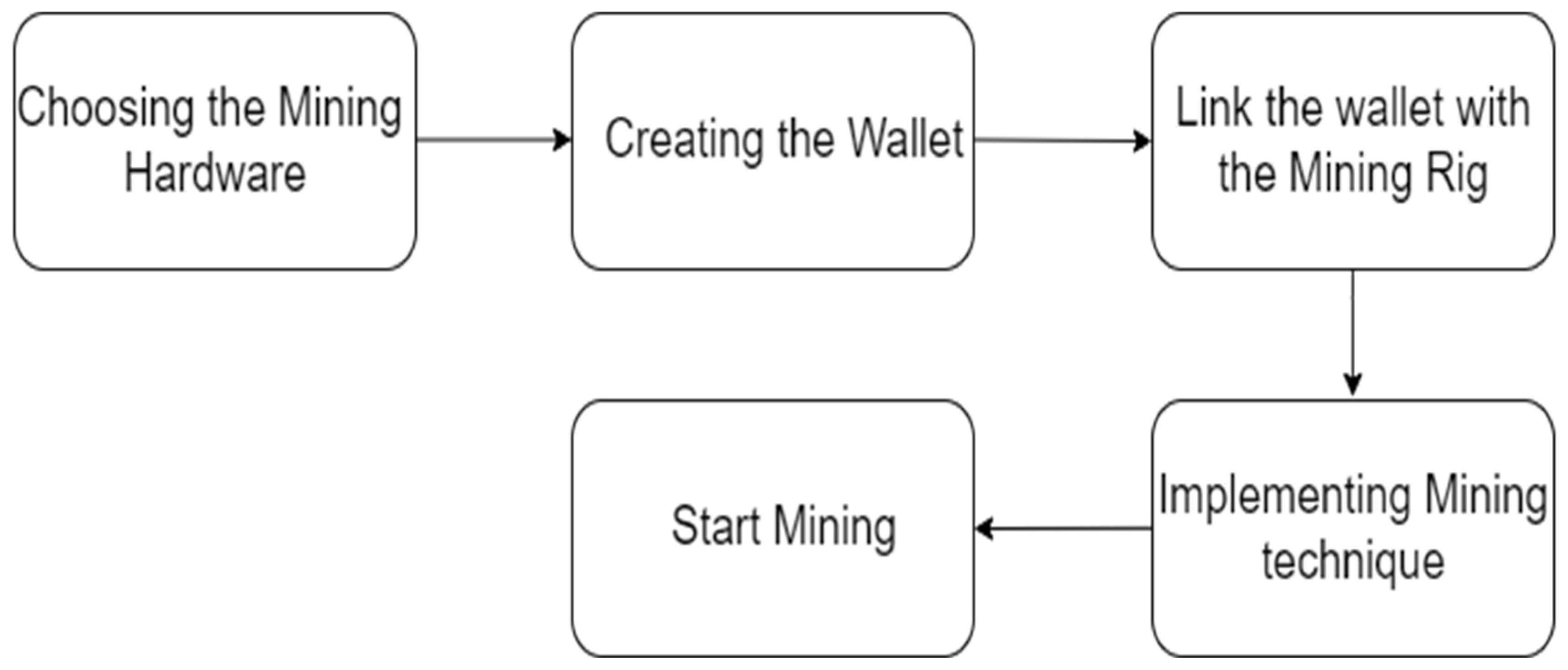

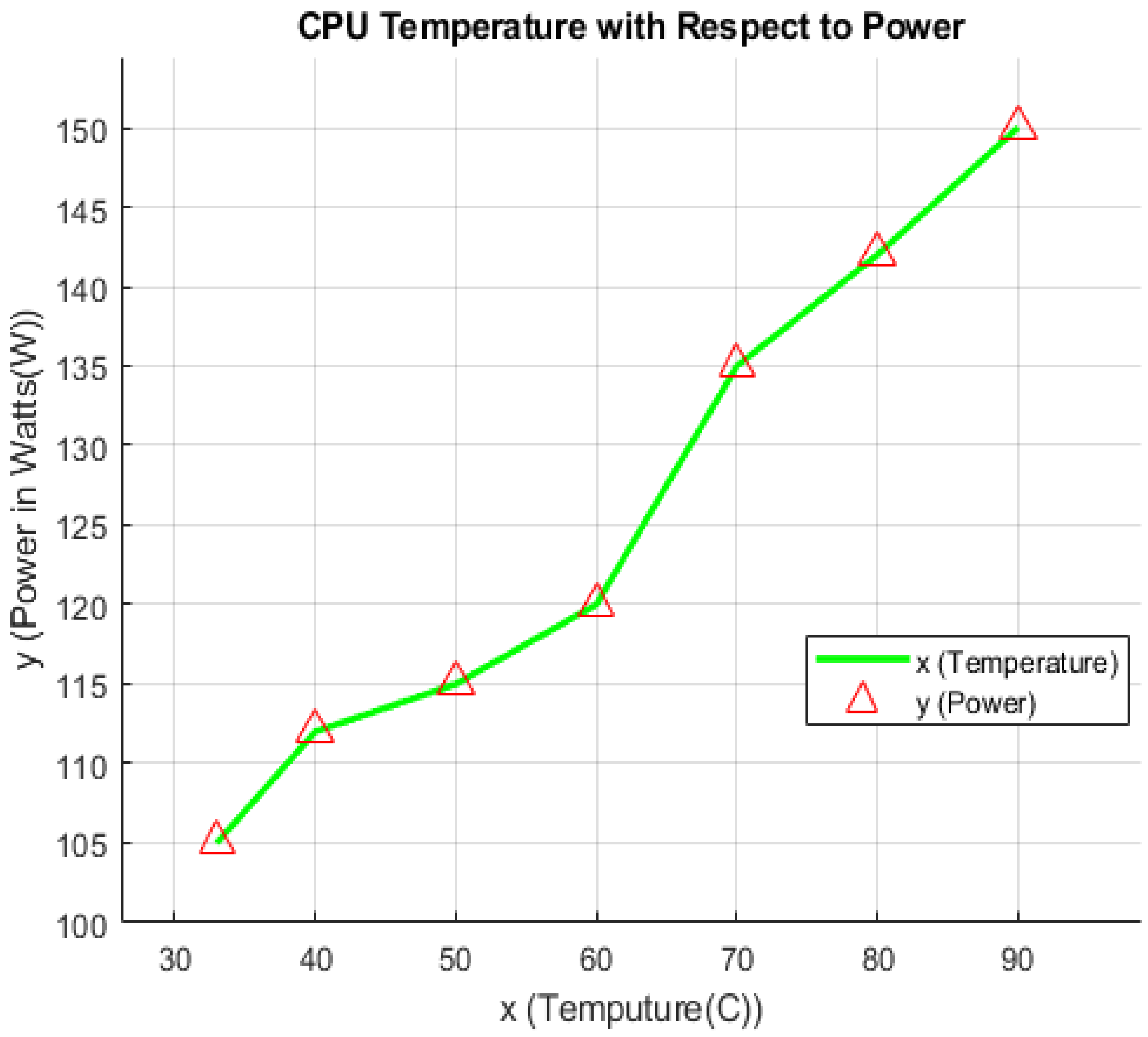
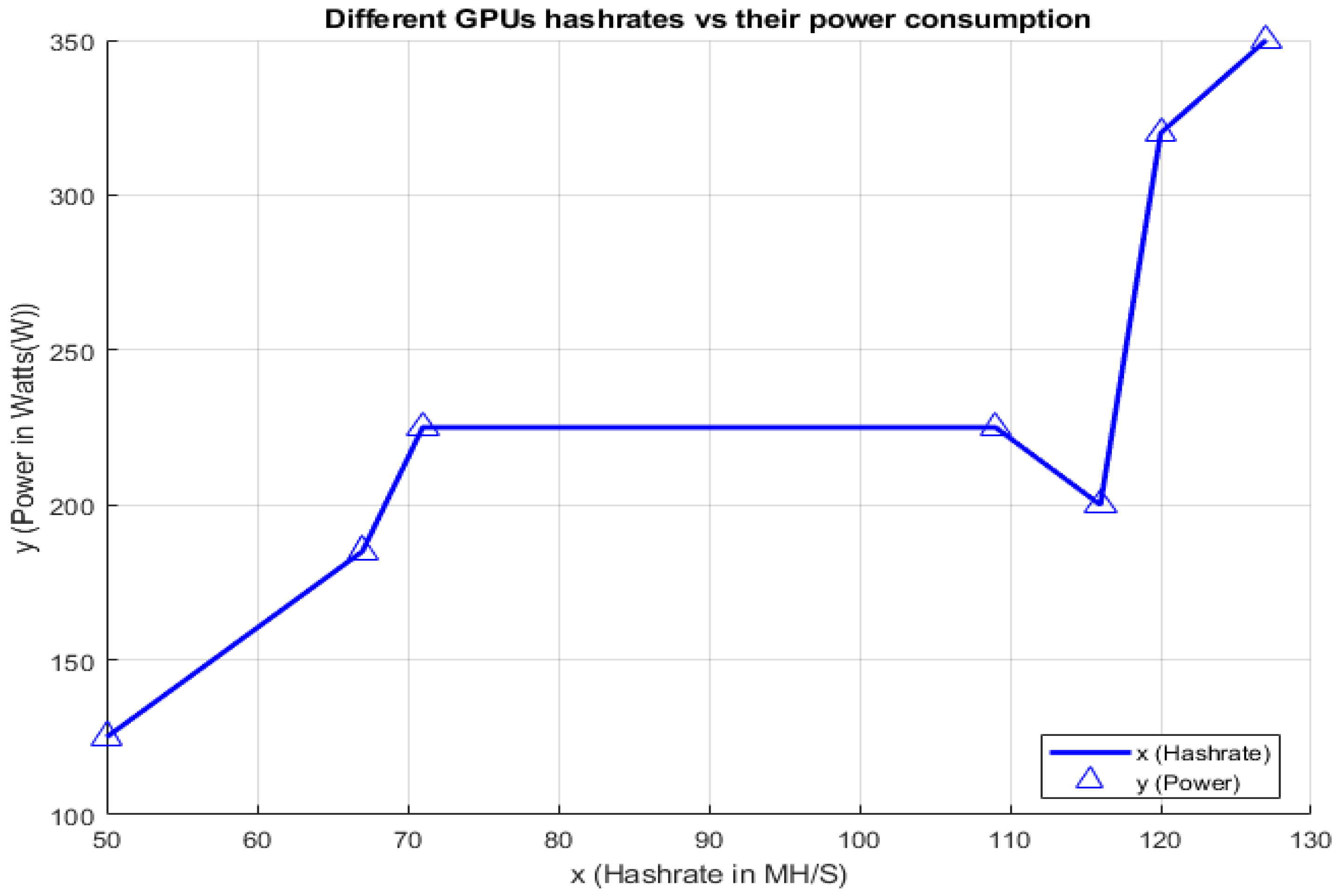
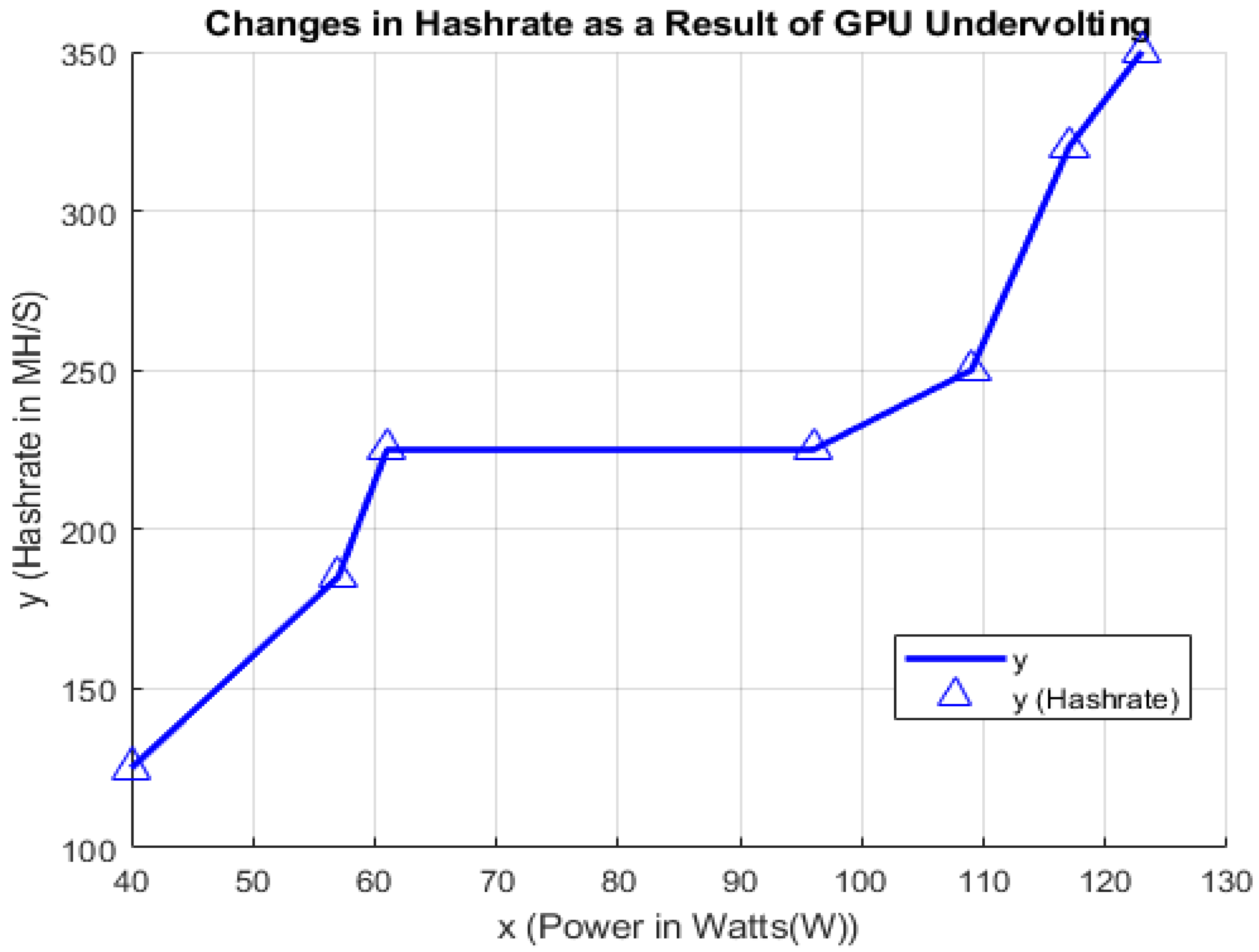
| Parameters | CPU | GPU |
|---|---|---|
| Speed | 2256 bit | 3200 bit |
| Energy Efficiency | Not energy efficient | Energy efficient |
| Maintenance Level | Difficult to maintain | Easy to maintain |
| Difficult | Harder to mine | Effortless mining |
| Memory | No memory | Has memory depending upon the GPU |
| Installation | Not easy to install | Easy to install |
| Support | No regular updates | Has regular software updates |
| Optimization | Not easy to optimize | One-click optimization |
| GPU Power Consumption (Watts) | MHz | Hash Rate (MH/S) | Fan Speed (RPM) |
|---|---|---|---|
| 200 W | 1750 | 60 MH/S | 1250 RPM |
| 215 W | 1800 | 62.39 MH/S | 1350 RPM |
| 231 W | 1850 | 65.41 MH/S | 1400 RPM |
| 262 W | 1900 | 67.61 MH/S | 1460 RPM |
| 291 W | 1950 | 69.11 MH/S | 1570 RPM |
| 315 W | 2000 | 71.28 MH/S | 1650 RPM |
| 320 W | 2050 | 73.91 MH/S | 1670 RPM |
| GPU Power Consumption | Profit Per Day | Electricity Savings |
|---|---|---|
| 200 W | 321.85 Rs | 40.837 Rs |
| 215 W | 328.48 Rs | 40.837 Rs |
| 231 W | 336.12 Rs | 40.837 Rs |
| 262 W | 349.99 Rs | 40.837 Rs |
| 291 W | 362.35 Rs | 40.837 Rs |
| 315 W | 374.94 Rs | 40.837 Rs |
| 320 W | 380.21 Rs | 40.837 Rs |
| GPU | Power Consumption | Clock Speeds | Hash Rates | CUDA Cores | VRam |
|---|---|---|---|---|---|
| RTX 3090 OC | 350 W | 1371 MHz | 120 MH/s | 10,496 | 24 GB GDDR6X |
| RTX 3080 OC | 320 W | 1350 MHZ | 100 MH/S | 8704 | 10 GB GDDR6X |
| RTX 3060 Ti | 200 W | 1400 MHz | 60 MH/S | 4864 | 8 GB GDDR6X |
| AMD RX 5700 XT | 225 W | 1445 MHz | 1090.3 H/S | 2304 SP | 8 GB GDDR6 |
| RTX 2070 | 225 W | 1596 MHz | 710.0 H/S | 2304 | 8 GB GDDR6 |
| AMD RX 580 | 185 W | 1241 MHz | 470.0 H/S | 2048 SP | 8 GB GDDR5 |
| GTX 1660 Super | 125 W | 1513 MHz | 505.0 H/S | 1408 | 6 GB GDDR6 |
| Constraints | Our Work | Dev [3] | Alkaeed [7] | Fadeyi [24] | Han [32] |
|---|---|---|---|---|---|
| Cryptocurrency | Monero | Bitcoin | Ethereum | Ravencoin | Dogecoin |
| Algorithm | RandomX | SHA-256 | Keccak-256 | KAWPOW | Scrypt |
| AverageHash rate | 427.97 MH/s | 193 TH/s | 12,638 MH/s | 3.51 TH/s | 461 MH/s |
| Mining Hardware | RTX GPU | ASIC | RTX GPUs | Nvidia GPUs | RTX GPU |
| Power Consumption | 190 kWh | 214.93 TWh | 113 TWh | 194 kWh | 101 kWh |
| Energy source | Renewable Energy | Renewable Energy | Renewable Energy | Renewable Energy | Renewable Energy |
| Overclocking | ✓ | ✖ | ✖ | ✖ | ✖ |
| Undervolting | ✓ | ✖ | ✖ | ✖ | ✖ |
| Mining Efficiency | ✓ | ✖ | ✖ | ✖ | ✖ |
| Hardware optimisation | ✓ | ✖ | ✖ | ✖ | ✖ |
Publisher’s Note: MDPI stays neutral with regard to jurisdictional claims in published maps and institutional affiliations. |
© 2022 by the authors. Licensee MDPI, Basel, Switzerland. This article is an open access article distributed under the terms and conditions of the Creative Commons Attribution (CC BY) license (https://creativecommons.org/licenses/by/4.0/).
Share and Cite
Shuaib, M.; Badotra, S.; Khalid, M.I.; Algarni, A.D.; Ullah, S.S.; Bourouis, S.; Iqbal, J.; Bharany, S.; Gundaboina, L. A Novel Optimization for GPU Mining Using Overclocking and Undervolting. Sustainability 2022, 14, 8708. https://doi.org/10.3390/su14148708
Shuaib M, Badotra S, Khalid MI, Algarni AD, Ullah SS, Bourouis S, Iqbal J, Bharany S, Gundaboina L. A Novel Optimization for GPU Mining Using Overclocking and Undervolting. Sustainability. 2022; 14(14):8708. https://doi.org/10.3390/su14148708
Chicago/Turabian StyleShuaib, Mohammed, Sumit Badotra, Muhammad Irfan Khalid, Abeer D. Algarni, Syed Sajid Ullah, Sami Bourouis, Jawaid Iqbal, Salil Bharany, and Lokesh Gundaboina. 2022. "A Novel Optimization for GPU Mining Using Overclocking and Undervolting" Sustainability 14, no. 14: 8708. https://doi.org/10.3390/su14148708
APA StyleShuaib, M., Badotra, S., Khalid, M. I., Algarni, A. D., Ullah, S. S., Bourouis, S., Iqbal, J., Bharany, S., & Gundaboina, L. (2022). A Novel Optimization for GPU Mining Using Overclocking and Undervolting. Sustainability, 14(14), 8708. https://doi.org/10.3390/su14148708










